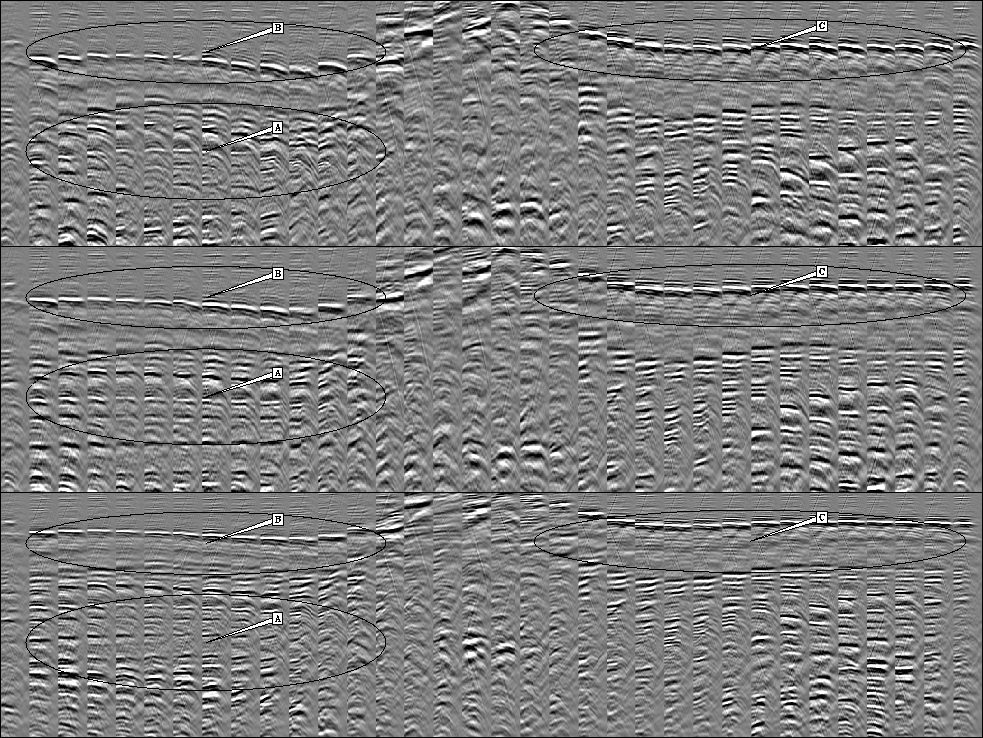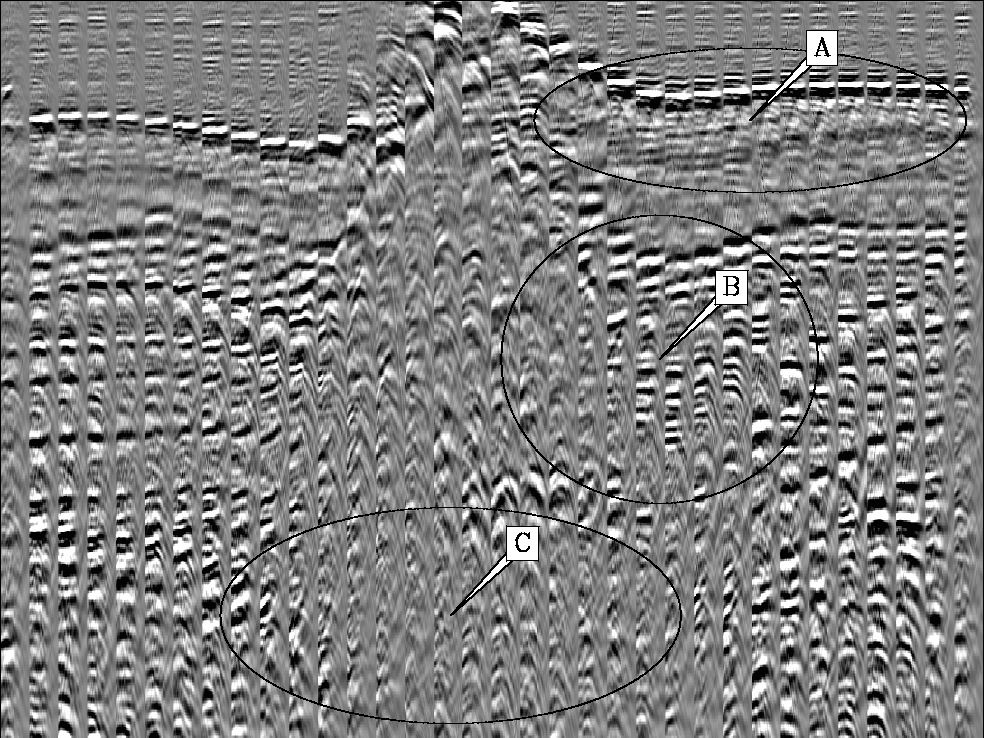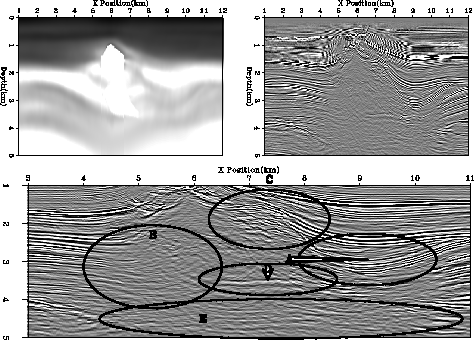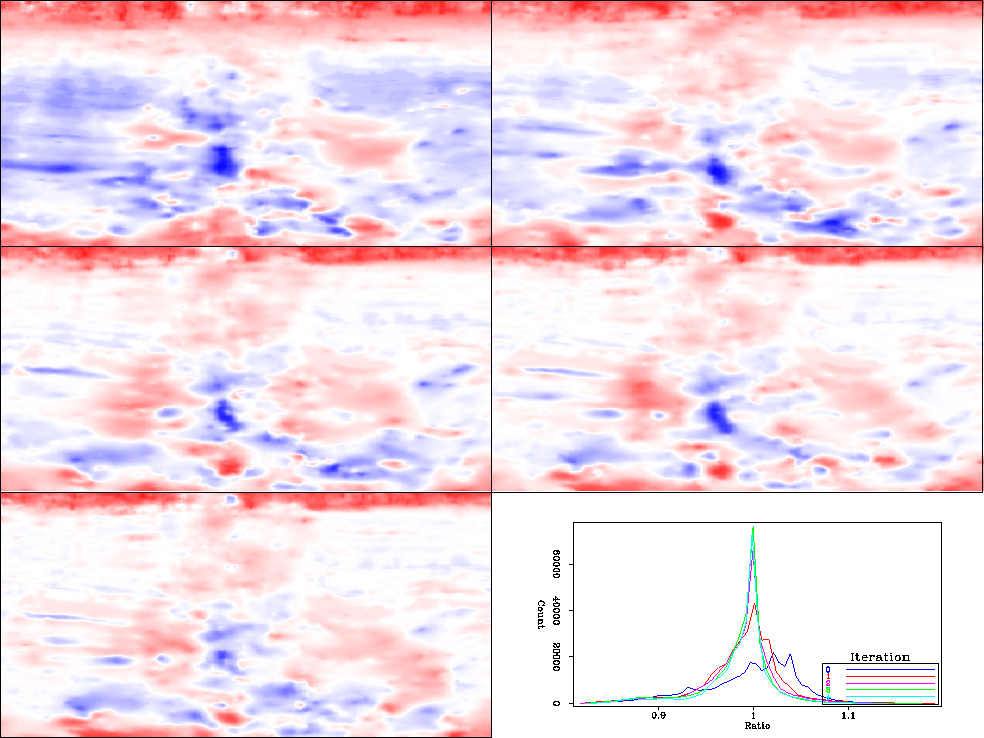




Next: CONCLUSIONS
Up: R. Clapp: Ray based
Previous: Back projection
To test the methodology I chose a 2-D line from a 3-D North Sea dataset.
Figure 6 shows
- the initial velocity model (top-left
panel),
- the initial migration (top-right), and
- a zoomed in portion of the model with three regions highlighted
for future comparisons (bottom).
combo.vel0
Figure 6
The initial model and migration.
The top-left panel shows the velocity
model and the top-right panel shows the migrated
image using this velocity.
The bottom panel shows a blow up around the salt body.
`A' - `E' will be used later in the text for comparison.
![[*]](http://sepwww.stanford.edu/latex2html/movie.gif)





I performed one non-linear iteration of tomography using three different
approaches. The top panel of Figure 7 shows
the result of using vertical moveout as the basis for determining
the time errors. The center panel is again the result of using vertical
moveout for the time error calculation with additional constraints on
what points are used for back projection and limiting
the effect of bad moveouts Clapp (2002). The bottom panel is the result of
using residual migration.
The area signified with `A' shows the problems with using all
of the data (top panel). Note how the gathers have tremendous,
inconsistent curvature. When we discount this information (center panel)
we get more reasonable gathers. Using residual migration to estimate
 we can get the same, or better, gathers without
throwing away a portion of the data.
The problem with throwing away a portion of the data can been at `C'
and especially `B'.
We threw away the information that would help
us flatten the reflector in order to avoid the
problems seen in the top panel. Smply using vertical
moveout analysis, it takes several non-linear iterations
to achieve the same level of flatness at `A' and `B' that
is seen with the first non-linear iteration using a
residual migration measure.
we can get the same, or better, gathers without
throwing away a portion of the data.
The problem with throwing away a portion of the data can been at `C'
and especially `B'.
We threw away the information that would help
us flatten the reflector in order to avoid the
problems seen in the top panel. Smply using vertical
moveout analysis, it takes several non-linear iterations
to achieve the same level of flatness at `A' and `B' that
is seen with the first non-linear iteration using a
residual migration measure.
gathers.iter1
Figure 7 Each panel
represents every 15th CRP gather between 1 and 4 km after one non-linear
iteration of tomography. The top panel is
the result of performing tomography calculating  using
vertical moveout. The center panel is using vertical moveout
discounting data with significant moveout. The bottom
panel shows the result of using residual migration as
the basis of the
using
vertical moveout. The center panel is using vertical moveout
discounting data with significant moveout. The bottom
panel shows the result of using residual migration as
the basis of the  calculation. Note the improved
flatness of the CRP gathers from top to bottom.
calculation. Note the improved
flatness of the CRP gathers from top to bottom.
![[*]](http://sepwww.stanford.edu/latex2html/movie.gif)





Figure 8 shows every 15th CRP gather after
five non-linear iterations. Note how the moveout in reflector at `A' is
virtually flat. Within valley structure, `B', there is little
remaining residual moveout. The most interesting location is `C' where
we are begining to see coherent events under the salt.
Figure 9 shows
the resulting velocity and image after five non-linear iterations.
The salt top reflection is now clean.
Note how the valley structure at `A' is well imaged. At `B'
we can follow reflectors all the way to what appears to be the salt edge.
On the top-left portion of the salt, `C', we have gone from a jumbled mess
(Figure 6) to being able to clearly follow reflectors.
At `D' we see a consitant, strong amplitude, salt bottom reflection.
Finally, at `E' we are begining to see strong events
under the salt. Further improvement requires going to 3-D.
gathers.final
Figure 8 Every 15th
CRP gather after five non-linear iterations. Note the flat
gathers at `A' and `B' and the forming of coherent
moveout below the salt at `C'.




 combo.final
combo.final
Figure 9 Data after five
non-linear iterations of
tomography with residual migration based moveout analysis.
The top-left panel shows the velocity
model and the top-right panel shows the migrated
image using this velocity.
The bottom panel shows a blow up around the salt body.
Note how the valley structure at `A' is well imaged. At `B'
we can follow reflectors all the way to what appears to be the salt edge.
On the top-left portion of the salt, `C', we have gone from a jumbled mesh
(Figure 6) to being able to clearly follow reflectors.
At `D' we see a consistent, strong amplitude, salt bottom reflection.
Finally, at `E' we are begining to see the forming of fairly strong events
under the salt.
![[*]](http://sepwww.stanford.edu/latex2html/movie.gif)





Another way to evaluate image improvement is to look at the
 values after successive iterations. Figure 10
show the
values after successive iterations. Figure 10
show the  values after zero to four iterations (left to right,
top to bottom). The figure demonstrates that as we progress in
iteration the
values after zero to four iterations (left to right,
top to bottom). The figure demonstrates that as we progress in
iteration the  value tends towards 1, indicating
that the problem is converging.
value tends towards 1, indicating
that the problem is converging.
ratios
Figure 10 The residual moveout measure as
a function of non-linear iteration. The top-left is the initial
moveout, the top-right after one iteration, etc. The bottom-right
panel shows a histogram for each of the  maps.
Note how the points cluster towards 1 as we progress in iteration. Note how
the ratio tends towards 1 (no-moveout, white) as we progress.
The red stripe on top is due to the severe early mute.
The offset to angle transform has an edge effect that causes
the data to curve up. As a result the best flatness is obtained
with a very low
maps.
Note how the points cluster towards 1 as we progress in iteration. Note how
the ratio tends towards 1 (no-moveout, white) as we progress.
The red stripe on top is due to the severe early mute.
The offset to angle transform has an edge effect that causes
the data to curve up. As a result the best flatness is obtained
with a very low  value. These values are ignored in the inversion.
value. These values are ignored in the inversion.
![[*]](http://sepwww.stanford.edu/latex2html/movie.gif)










Next: CONCLUSIONS
Up: R. Clapp: Ray based
Previous: Back projection
Stanford Exploration Project
11/11/2002
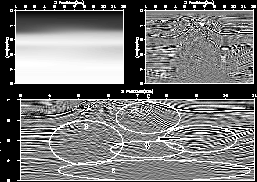
![[*]](http://sepwww.stanford.edu/latex2html/movie.gif)
